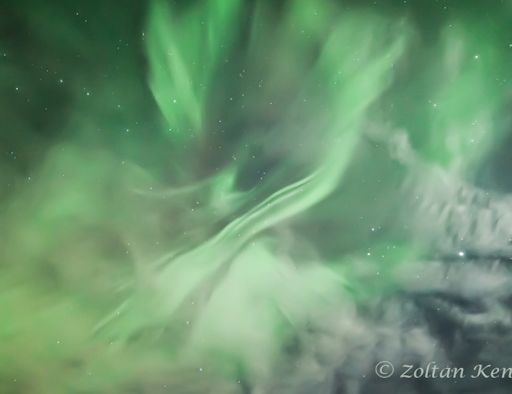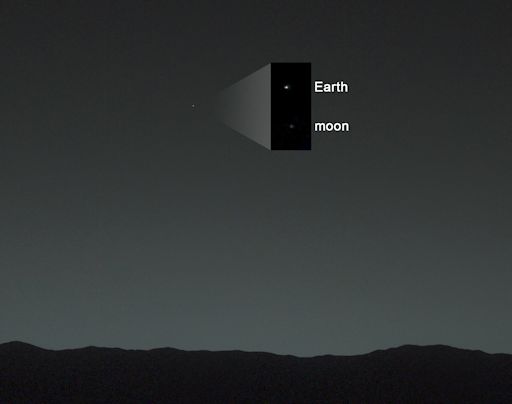GOOD-BYE SUNSPOTS, HELLO RADIATION STORM?: Today, big sunspots AR1967 and AR1968 are rotating over the sun's western limb to begin a two-week transit of the sun's farside. Ironically, this could result in elevated levels of radiation near Earth. At their current location, the two sunspots are well-connected to our planet by the sun's spiraling magnetic field. Any flares today could funnel energetic particles in our direction, possibly triggering a radiation storm. Solar flare alerts: text, voice
MAGNETIC UNREST: Earth's magnetic field is still reverberating from the impact of a CME on Feb. 7th. Intermittent storming around the poles has produced bright auroras across Scandinavia, Iceland and Canada. Zoltan Kenwell sends this picture from Edmonton, Alberta:
"I was driving home when I noticed a dim green blob on the eastern horizon," says Kenwell. "I pulled off the highway for a better look and, to my surprise, I saw this corona dancing right above me.
The reverberations are subsiding now, but they could begin anew on Sunday when a solar wind stream is expected to sweep past Earth. NOAA forecasters estimate a 45% chance of polar geomagnetic storms on Feb. 9-10. High-latitude sky watchers should remain alert for auroras. Aurora alerts: text, voice
CURIOSITY PHOTOGRAPHS EARTH: Last year when the Cassini spacecraft photographed Earth through the rings of Saturn, the whole world was alerted to smile and wave. Last week, Curiosity did the same thing with less fanfare. Except for a few scientists, no one knew the Mars rover would be taking this picture of the Earth-Moon system on Jan. 31st:
Mission controllers used the left eye of Curiosity's Mast Camera (Mastcam) to capture the scene about 80 minutes after local sunset in the Dingo Gap. Our planet was the brightest thing in the darkening Martian sky. A human observer with normal vision, if standing on Mars, would have easily seen Earth and the Moon as two distinct "evening stars." The distance to Earth when Curiosity took the photo was about 99 million miles. For more information about Curiosity's adventures on Mars, visit mars.jpl.nasa.gov.

Solar wind
speed: 444.6 km/sec
density: 2.0 protons/cm3
explanation | more data
Updated: Today at 1807 UT
X-ray Solar Flares
6-hr max: M1 1617 UT Feb09
24-hr: M1 1617 UT Feb09
explanation | more data
Updated: Today at: 1800 UT
![]()
Daily Sun: 09 Feb 14
Departing sunspots AR1967 and AR1968 pose a declining threat for Earth-directed flares. Credit: SDO/HMI
![]()
Sunspot number: 186
What is the sunspot number?
Updated 09 Feb 2014
Spotless Days
Current Stretch: 0 days
2014 total: 0 days (0%)
2013 total: 0 days (0%)
2012 total: 0 days (0%)
2011 total: 2 days (<1%)
2010 total: 51 days (14%)
2009 total: 260 days (71%)
Update 09 Feb 2014
The Radio Sun
10.7 cm flux: 172 sfu
explanation | more data
Updated 09 Feb 2014
![]()
Current Auroral Oval:
Switch to: Europe, USA, New Zealand, Antarctica
Credit: NOAA/POES
![]()
Planetary K-index
Now: Kp= 3 quiet
24-hr max: Kp= 5 storm
explanation | more data
Interplanetary Mag. Field
Btotal: 6.6 nT
Bz: 4.2 nT south
explanation | more data
Updated: Today at 1806 UT
![]()
Coronal Holes: 09 Feb 14
A solar wind stream flowing from the indicated coronal hole should reach Earth on Feb. 9-10. Credit: SDO/AIA.






